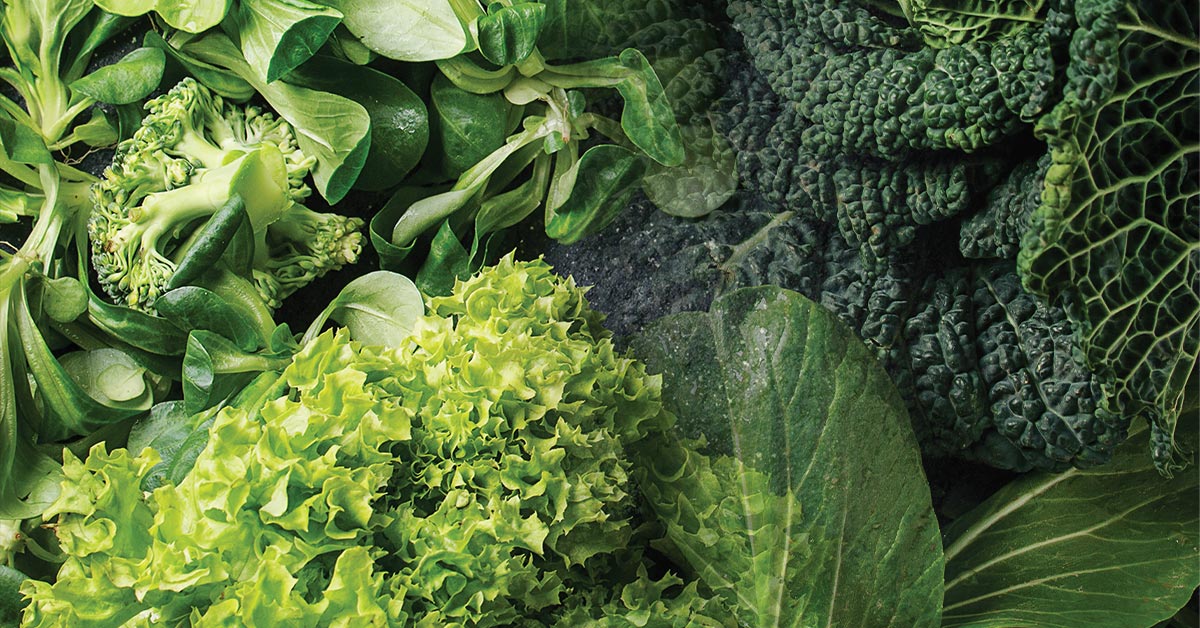As we leap into February, hearts surround us: in the stores, in our feeds, in every corner of our lives. Yes, yes. We get it. Valentine's Day is coming and love is in the air. And, while not all of us may have affection for that aspect of this second month of the year, all of these motifs are also a gentle reminder to take care of our hearts—in all ways! It's no mistake that February was chosen as Heart Health Month; it's simply hard to ignore.
Given that cardiovascular disease is the leading cause of death globally, according to data from the World Health Organization, and no. 1 for women in the U.S. per the CDC, heart health should be top of mind. And, though red may be the color du jour, green is the real darling, not just for our hearts, but for our entire bodies.
We're talking about leafy greens, here, and—wow—can they pack a punch. True superfoods filled with an array of vitamins, minerals, and phytonutrients, leafy greens can reduce a number of disease risks, boost immunity, and support gut, bone, and skin health, among other benefits. They're also high in fiber and low in energy, making them ideal for incorporating into our daily meals.
To help us understand these powerhouses better, we talked with Holly Dykstra, also known as The GR Dietitian. Dykstra, who worked with Corewell Health for more than a decade before starting her own private practice, is a registered dietitian and a certified intuitive eating specialist. She has all the details on greens, from what they do to how to get more of them.
When it comes to leafy greens, there are the usual suspects, such as spinach and kale, but Dykstra reminds us: there are plenty of others, including collard greens, arugula, swiss chard, microgreens, cabbage, endive, and even romaine lettuce. She also notes that a number of herbs fit the leafy green category, like basil, parsley, cilantro, tarragon, and mint—to name a few.
"All of these leafy greens have incredible nutrient density, but there are slight differences between each of them, and a lot of times it comes down to the different phytonutrients that they offer," Dykstra said. "All of the nutrients found in them can really help with cellular protection. They help to maintain DNA integrity, support DNA repair processes, and reduce the risk of oxidative stress and DNA damage. Just from a general aging standpoint, they're going to help a lot."
In addition, she notes that leafy greens not only improve heart health, they also reduce the risk of other chronic diseases like cancer and neurodegenerative diseases.
What's not to love?
For some of us, though, the trick might be integrating them into our diets. It's actually easier than it sounds! First, there are countless ways greens can be prepared, whether sautéed, roasted, or raw—sprinkled on eggs, blended into smoothies, or added to soups and sauces. Dykstra recommends finding a few personally enjoyable preparation methods, and also taking a cooking lesson or watching a video, and expanding the ways we could enjoy greens in different cuisines and cultural flavors.
If keeping fresh greens in the kitchen feels intimidating, or adds worries over using them before going bad, it's important to remember that freezing is an option. And, given that many store-bought frozen vegetables are flash frozen within 24-48 hours of being picked, their nutrient value can be even higher than fresh.
Also important to note is that greens contain nutrients that are fat soluble; vitamins A, D, E, and K, in particular. That means oil-based (or fat-based) dressings and dips, often misrepresented as the baddies of the food universe, are an excellent way to ensure our bodies are actually absorbing the nutrients some of these greens offer.
File that under things we didn't know!
"Overall, there are a lot of great components to all foods, and when we pair certain ones together, we can get even bigger results," Dykstra said. "Even if we're eating just a little bit here and there, we're still giving our bodies those helpful nutrients that help us thrive. And, if we're adding leafy greens most days of the week—even in small amounts—we're going to reap the benefits in the long term."
Allison Kay Bannister has been a West Michigan resident since 1987 and a professional writer since 2002. A GVSU alumna, she launched her own freelance writing business in 2017. Allison is a cookie connoisseur, word nerd, aspiring gardener, and metastatic breast cancer thriver who loves traveling in Michigan and beyond, and enjoys art, world cuisine, wine, music, and making homemade preserves.
This article originally appeared in the Feb/Mar '24 issue of West Michigan Woman.




